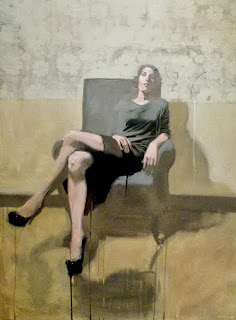I had the pleasure of viewing some of Antony Williams' paintings this weekend at the Toronto Art Fair. The meticulous quality of layers upon layers of brush work in tempera paint was marvelous to view in person. The depth of the medium itself was something to see. Through this layering, Williams establishes these figures appearing deep within thought, disconnected from the world around them. Maybe it is by nature of sitting after sitting after sitting (paintings may take upwards of a year of weekly sittings) where Williams painstakingly analyzes and depicts every nuance, these sitters have a chance for reflection, and in this mindful state they are depicted. I couldn't help but think of another painter while viewing Williams' works; Lucien Freud, specifically his earlier works. The layers of paint echoes an approach of Freud but also the atmosphere that the figures take part in share similarities. The viewer becomes engulfed in the figures head space, the workings of their mind. We see their exteriors but what intrigues us is what lives they have lived, what memories they have, what are the influences responsible for tampering with their beings to make them who they are as they stand before us represented in brush stroke layered on top of brush stroke. And what light was shed during each sitting? What became of these relationships between sitter and artist?
http://www.antony-williams.com/































